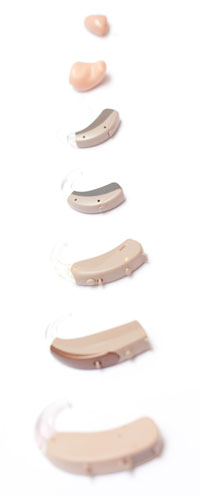Seven Myths Everyone Should Know About Hearing Aids
 Myth #1: If hearing loss is mild, a hearing aid isn’t necessary.
Myth #1: If hearing loss is mild, a hearing aid isn’t necessary.
Fact: Everyone's needs are different when it comes to hearing loss. An audiologist will be able to determine whether or not hearing aids are necessary for those with mild hearing loss. If you find yourself struggling to understand what people are saying in situations where you previously had little to no trouble, you may be experiencing mild hearing loss that could be addressed with hearing aids.
Myth #2: Only old people wear hearing aids.
Fact: Hearing loss affects all ages, even children. For children of any age, untreated hearing loss can lead to developmental delays and difficulties with speech, language and socialization. Early hearing loss detection and intervention programs help audiologists identify hearing loss as early as possible, even in newborn babies! Beyond childhood and adolescence, hearing loss may affect young and middle-age adults during their working years. Consulting with an audiologist can help address hearing problems early, to minimize the impact on work and quality of life.
Myth #3: Wearing two hearing aids is not necessary.
Fact: Those with hearing loss in both ears tend to function better with binaural (two-eared) hearing aids, which assist the wearer with understanding speech in crowded and noisy situations and detecting the direction of a sound. Binaural hearing aids also provide better sound quality and provide more natural auditory stimulation to the brain.
Myth #4: Hearing aids will amplify everything and make sounds too loud.
Fact: Audiologists can program digital hearing aids with different amplification levels that automatically adjust volume depending on the type of environment the user is in and the sound level. Hearing aids are programmed appropriately according to the wearer’s needs.
Myth #5: Hearing aids restore your hearing completely back to normal, similarly to how eyeglasses can restore vision to 20/20.
Fact: Hearing aids are used to amplify sound so those with certain degrees of hearing loss can listen, communicate and participate in daily activities. Hearing aids do not “cure” hearing loss, but can substantially improve the wearer’s ability to interact with the world around them.
Those with untreated hearing loss may stop participating in some of the activities they enjoy – talking to relatives on the phone, going out to restaurants or going to the movie theater. While hearing aids do not make hearing “perfect” again, they can improve quality of life because they allow people to re-engage in the activities they enjoy.
Myth #6: Hearing aids are unattractive.
Fact: There are numerous types of hearing aids, including some that are completely invisible in the ear canal or hidden behind the ear. Hearing aids can also be customized for wearers of all ages with different colors and patterns. Regardless of what type of hearing aid is required, users should feel proud that they’re taking control of their health and improving their quality of life.
Myth #7: I can’t use a cell phone or other audio devices if I have hearing aids.
Fact: Modern hearing aids can work seamlessly with high-tech devices like smartphones and tablets. Wireless technology allows certain types of hearing aids to connect directly to phones, tablets, TVs or other audio devices. An audiologist can recommend certain products for connecting to your electronic devices.
If you have a question about your hearing aids or think you may need one, contact the Pennsylvania Ear Institute today for an appointment.